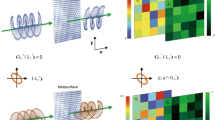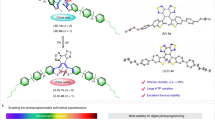Abstract
Organic holographic materials are pursued as versatile and cheap data-storage materials. It is generally assumed that under steady-state conditions, only photorefractive holographic media exhibit a non-local response to a light-intensity pattern, which results in an asymmetric two-beam coupling or ‘gain’, where intensity is transferred from one beam to the other as a measure of writing efficiency. Here, we demonstrate non-local holographic recording in a non-photorefractive material. We demonstrate that reversible photoisomerization gratings recorded in a non-photorefractive azo-based material exhibit large optical gain coefficients beyond 1,000 cm−1, even for polarization gratings. The grating characteristics differ markedly from classical photorefractive features, but can be modelled by considering the influence of the Poynting vector on the photoisomerization. The external control of the Poynting vector enables manipulation of the gain coefficient, including its sign (the direction of energy exchange), a novel phenomenon we refer to as ‘gain steering’. A very high sensitivity of about 100 cm2 J−1 was achieved. This high sensitivity, combined with a high spatial resolution, suggests a great technical advantage for applications in image processing and phase conjugation.
This is a preview of subscription content, access via your institution
Access options
Subscribe to this journal
Receive 12 print issues and online access
$259.00 per year
only $21.58 per issue
Buy this article
- Purchase on Springer Link
- Instant access to full article PDF
Prices may be subject to local taxes which are calculated during checkout





Similar content being viewed by others
References
Günter, P. & Huignard, J.-P. (eds) Topics in Applied Physics Vol. 61 and 62 (Springer, Berlin, 1989).
Meerholz, K., Volodin, B. L., Sandalphon, Kippelen, B. & Peyghambarian, N. A photorefractive polymer with high optical gain and diffraction efficiency near 100%. Nature 371, 497–500 (1994).
Ostroverkhova, O. & Moerner, W. E. Organic photorefractives: mechanisms, materials and applications. Chem. Rev. 104, 3267–3314 (2004).
Natansohn, A. & Rochon, P. Photoinduced motions in azo-containing polymers. Chem. Rev. 102, 4139–4175 (2002).
Delaire, J. A. & Nakatani, K. Linear and nonlinear optical properties of photochromic molecules and materials. Chem. Rev. 100, 1817–1845 (2000).
Berg, R. H., Hvilsted, S. & Ramanujam, P. S. Peptide oligomers for holographic storage. Nature 383, 505–508 (2004).
Rasmussen, P. H., Ramanujam, P. S., Hvilsted, S. & Berg, R. H. A remarkably efficient azobenzene peptide for holographic information storage. J. Am. Chem. Soc. 121, 4738–4743 (1999).
Cheben, P., del Monte, F., Worsfold, J. D., Carlsson, D. J. & Mackenzie, J. D. A photorefractive organically modified silica glass with high optical gain. Nature 408, 64–67 (2000).
Lagugne-Labarthet, F. et al. Spectroscopic and optical characterization of a series of azobenzene-containing side-chain liquid crystalline polymers. Macromolecules 33, 6815–6823 (2000).
Darracq, B., Chaput, F., Lahlil, K., Levy, Y. & Boilot, J.-P. Photoinscription of surface relief gratings on azo-hybrid gels. Adv. Mater. 10, 1133–1136 (1998).
Frey, L. et al. Surface and volume grating investigated by the moving grating technique in sol–gel materials. Opt. Commun. 173, 11–16 (2000).
Khoo, I. C. Holographic grating formation in dye- and fullerene C60-doped nematic liquid-crystal film. Opt. Lett. 20, 2137–2139 (1995).
Raschellà, R. et al. Photorefractive gratings in DR1-doped hybrid sol–gel films. Opt. Mater. 25, 419–423 (2004).
Sturman, B. I. Dynamic holography effects in ferroelectrics induced by spatially oscillating photovoltaic currents. J. Opt. Soc. Am. B 8, 1333–1341 (1991).
Shumelyuk, A., Hartwig, U., Buse, K., Odulov, S. & Woike, T. Linearity of index grating recording with spatially oscillating photovoltaic currents. J. Opt. Soc. Am. B 23, 857–860 (2006).
Ramos, G., Belenguer, T., Bernabeu, E., del Monte, F. & Levy, D. A Novel photoconductive PVK/SiO2 interpenetrated network prepared by the sol–gel process. J. Phys. Chem. B 107, 110–112 (2003).
Bittner, R. & Meerholz, K. in Photorefractive Materials and their Applications (eds Günter, P. & Huignard, J. P.) (Springer, Berlin, 2006).
Hasegawa, M., Yamamoto, T., Kanazawa, A., Shiono, T. & Ikeda, T. Photochemically induced dynamic grating by means of side chain polymer liquid crystals. Chem. Mater. 11, 2764 (1999).
Ishow, E. et al. Structural and photoisomerization cross studies of polar photochromic monomeric glasses forming surface relief gratings. Chem. Mater. 18, 1261–1267 (2006).
Mecher, E. et al. Near-infrared sensitivity enhancement of photorefractive polymer composites by pre-illumination. Nature 418, 959–964 (2002).
Steenwinckel, D. V., Hendrickx, E., Persoons, A., Van den Broeck, K. & Samyn, C. Influence of the chromophore ionization potential on speed and magnitude of photorefractive effects in poly(N-vinylcarbazole) based polymer composites. J. Chem. Phys. 112, 11030–11037 (2000).
Long, T. M. & Swager, T. M. Using internal free volume to increase chromophore alignment. J. Am. Chem. Soc. 124, 3826–3827 (2002).
Chaput, F. et al. New nonlinear sol–gel films exhibiting photorefractivity. Chem. Mater. 8, 312–314 (1996).
Würthner, F., Wortmann, R. & Meerholz, K. Chromophore design for photorefractive organic materials. ChemPhysChem 3, 17–31 (2002).
Kogelnik, H. Coupled wave theory for thick hologram gratings. Bell System Tech. J. 48, 2909–2947 (1969).
Sutter, K. & Günter, P. Photorefractive effects observed in the organic crystal 2-cyclooctylamino-5-nitropyridine doped with 7,7,8,8-tetracyanoquinodimethane. J. Opt. Soc. Am. B 7, 2274–2278 (1990).
Pedersen, H. C., Johansen, P. M. & Pedersen, T. G. Analytical modeling of two beam coupling during grating translation in photorefractive media. Opt. Commun. 192, 377–385 (2001).
Ashley, J. et al. Holographic data storage. IBM J. Res. Develop. 44, 341–368 (2000).
Acknowledgements
We gratefully acknowledge fruitful discussions with B. Sturman (Institute of Automation and Electrometry, Novosibirsk), K. Buse (University of Bonn), S. Köber, A. Ruhl and M. Salvador (all University of Cologne). We also thank N. Benter (University of Bonn) for electro-optic measurements. F.d.M. thanks MAT2006-02394 for financial support.
Author information
Authors and Affiliations
Corresponding author
Supplementary information
Supplementary Information
Supplementary Figures S1–S5 (PDF 202 kb)
Rights and permissions
About this article
Cite this article
Gallego-Gómez, F., del Monte, F. & Meerholz, K. Optical gain by a simple photoisomerization process. Nature Mater 7, 490–497 (2008). https://doi.org/10.1038/nmat2186
Received:
Accepted:
Published:
Issue Date:
DOI: https://doi.org/10.1038/nmat2186
This article is cited by
-
Molecular design of photorefractive polymers
Polymer Journal (2016)
-
Functionalization of the living diatom Thalassiosira weissflogii with thiol moieties
Nature Communications (2013)
-
Running holograms in azopolymer films
Applied Physics B (2013)



